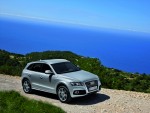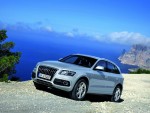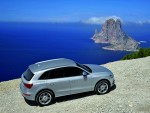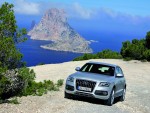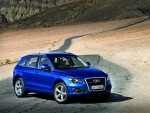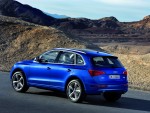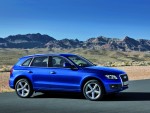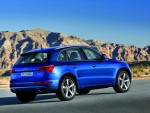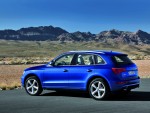2009 Audi Q5
2009 Audi Q5 Pictures & Specifications
Home »
Audi
Pictures & Wallpapers
Technical Specifications
Make: Audi
Model: Q5 3.0 TDI
Engine: 3.0 litre V6 diesel
Aspiration: Turbocharged
Maximum Power: 176 kW (240 hp) @ 4000 rpm
Maximum Torque: 500 Nm (369 lb-ft) @ 1500 rpm
Transmission: Seven-speed S tronic
Drivetrain: All-wheel drive
2009 Audi Q5
Audi Press Release
2 October 2008
Audi is opening up a new market segment: the Audi Q5 performance SUV combines the dynamism of a sport sedan with an impressively versatile interior and multiple talents for leisure and family use. Three powerful, efficient engines, quattro permanent all-wheel drive and agile suspension create an impressive technological package for on- and off-road use. The innovative seven-speed S tronic dual-clutch transmission and the Audi drive select driving dynamics system are other highlights.
Design, body and interior
The Audi Q5 is 4.63 metres (15.19 ft) long and 1.88 metres (6.17 ft) wide, but only 1.65 metres (5.41 ft) high, giving it the sportiest proportions in its field of competitors. Its drag coefficient of just 0.33 also represents a top figure for its category, and its design is elegant and sculptural. The front end is dominated by the large single-frame grille. Xenon plus headlamps with LED daytime running lights can be ordered, in which case the rear lights use light-emitting diodes too.
Large wheels and rising lines are features of the side view; the elegant roof contour, crowned by low-height roof rails, accentuates the Audi Q5’s slim appearance. The wraparound tailgate, like the hood, is made from lightweight aluminium. There are three versions to choose from for the exterior add-on parts – black (standard), colour-contrasting, or in the body colour. There are also two body packages. The S line exterior package creates a particularly sportier look, while the offroad style package has a grittier look thanks to the underbody guards at the front and rear, and 19-inch wheels.
The wheelbase of 2.81 metres (9.22 ft), the best figure in this segment, means that there is abundant space on board the Audi Q5. The seats are ergonomically shaped and versatile in their layout. The rear seat back angle can be adjusted and the seats can be folded flat onto the seat cushions very easily, by releasing the catches in the cargo area. This increases the cargo capacity from 540 to 1,560 litres (19.07 to 55.09 cubic feet), and there is a second storage compartment under the floor panel. A load guard is standard, and a cargo-securing kit, a dirt-resistant tray and electric drive for the tailgate are available as optional extras.
The Q5 performance SUV is a highly talented all-rounder for sport, leisure and family use. As an option Audi can supply the ‘rear seat bench plus’, which can be adjusted forward or back by 100 millimetres (3.94 in) and incorporates a load-through hatch. There is also the option of a folding seat back for the front passenger’s seat. The Audi Q5 comes with an array of factory-fitted storage compartments and power sockets; an optionally available climate-controlled cup holder keeps drinks cool or warm. Another ingenious detail is the fixing point in the front passenger’s footwell, to which various storage facilities can be secured.
The Audi Q5’s cockpit has a bias towards the driver; its controls can be operated with intuitive ease. Choice materials such as aluminium, wood, chrome, leather and Alcantara lend the interior even greater appeal. The front seat belt force limiters and airbags act together in a new, highly intelligent way. The body contains a high proportion of high- and ultra-high-strength steel components. These reduce weight and at the same time improve crash safety, rigidity and vibration suppression. The impression created by this performance SUV is of an utterly robust, comfortable and quiet car.
Engines
The Audi Q5 reaches the market with a choice of three engines – one gasoline and two TDI. All of them have direct fuel injection and are turbocharged. Their major strengths are high performance, beefy pulling power, refined running and of course impressive fuel efficiency.
The 2.0 TFSI combines three hi-tech features – turbocharging, gasoline direct injection, and the innovative Audi valvelift system for variable control of valve lift. Its high torque of 350 Nm (258.15 lb-ft) is already reached at 1,500 rpm, and maintained constantly up to 4,200 rpm; maximum output is 155 kW (211 hp). The Q5 2.0 TFSI reaches 100 km/h (62.14 mph) in 7.2 seconds from a standing start, and has a top speed of 222 km/h (137.94 mph). Its fuel consumption averages just 8.5 litres per 100 km (27.67 US mpg).
The other two-litre engine is the 2.0 TDI, which has a new common rail fuel injection system for extremely refined running. Like the gasoline engine, it has two balancer shafts. Also developing 350 Nm (258.15 lb-ft) of torque from 1,750 to 2,500 rpm on the engine speed scale, this diesel is capable of powerful acceleration and develops a high output of 125 kW (170 hp).
It has an average fuel consumption of just 6.7 litres per 100 km (35.11 US mpg). The two-litre TDI propels the Audi Q5 from zero to 100 km/h (62.14 mph) in 9.5 seconds, and on up to a top speed of 204 km/h (126.76 mph)
The 3.0 TDI is the most powerful engine in the range. This V6 diesel summons up 176 kW (240 hp) and – from 1,500 to 3,000 rpm – 500 Nm (368.78 lb-ft) of torque. This superlative power takes the Audi Q5 from a standstill to 100 km/h (62.14 mph) in 6.5 seconds and on to a top speed of 225 km/h (139.81 mph). Yet on average the three-litre engine needs only 7.5 litres of fuel per 100 km (31.36 US mpg).
As on the Audi A4, the driveline of the Audi Q5 has its differential located ahead of the clutch, and immediately behind the engine. This repositions the front axle well forward, resulting in a long wheelbase and ideal axle load distribution. This in turn produces unruffled directional stability, a high standard of comfort and thrilling dynamism. Audi equips all versions of the Q5 with quattro permanent all-wheel drive. This splits the power in a ratio of 40 percent to the front and 60 percent to the rear wheels. If need be, it can divert up to 65 percent of the torque to the front wheels, or as much as 85 percent to the rear.
Running gear
The running gear, too, underscores the dynamic character of the Audi Q5. The direct steering provides an intimate link between the driver and the road. The five-link front suspension and trapezoidal-link rear suspension are made substantially from aluminium, and the low-mounted steering gear transmits steering wheel movements directly to the wheels. Large brakes provide ample stopping power. 17-inch alloy wheels with size 235/65 tires are standard, but Audi can supply wheels measuring up to 20 inches in diameter as optional extras.
Audi’s performance SUV drives with sporty precision and unwavering stability, yet always provides a comfortable ride. Its ESP stabilisation system incorporates new functions that competitors are unable to match. For instance, the ESP has a sensor that identifies when a roof rack is fitted, and then knows that the Audi Q5’s center of gravity is higher. In this instance the ESP cuts in slightly earlier as the handling limits are approached; this allows the system to apply a very dynamic basic characteristic. With a trailer load limit of 2.4 metric tons (5291.09 lb) (braked, maximum gradient eight percent) the Audi Q5 is a powerful towing vehicle.
But the Audi Q5 also excels on rough terrain. Its maximum gradient is an exceptionally high 31 degrees. The angles of approach and departure are 25 degrees each, and the ramp breakover angle, where the wheelbase is the most significant factor, is 17.6 degrees. The ground clearance is a substantial 20 centimetres (7.87 in) and a wading depth of 50 centimetres (19.69 in) is permitted when driving through water.
The standard-fit hill descent assist makes driving down steep slopes safer by holding the speed to below 30 km/h (18.64 mph). The ESP and ABS have special mapped characteristics for off-road driving. The ESP majors on maximum traction in off-road conditions. The ABS automatically identifies the surface conditions and selects the ideal regulating strategy for sand, gravel or scree.
On the road, too, a whole package of optional high-end technologies makes the Audi Q5 driving experience even more captivating. The Audi drive select control system manages the engine’s throttle response, power assistance for the steering and the S tronic shift points in automatic mode. The driver determines at the push of a button whether these functions should have a predominantly comfortable, balanced or sporty response. If the MMI navigation plus system is also fitted, a fourth characteristic map is added that the driver can program as preferred.
Audi drive select can also be combined with two further innovative technologies – electronic control for the shock absorbers, and Audi dynamic steering. Equipped with a superposition gear, this varies the steering ratio and power assistance continuously – between a direct ratio at low speed and a more indirect one at high speed. Near the handling limits, the dynamic steering stabilises the Audi Q5 in tandem with the ESP by making slight adjustments to the steering angle at lightning speed.
Equipment and trim
The Audi Q5 comes as standard with automatic air conditioning and an audio system with eight speakers. If the MMI navigation plus system is ordered, numerous operating functions are concentrated on the MMI terminal on the center tunnel.
MMI, the best-in-market operating system, has entered a new generation – its operation via the large rotary pushbutton is now even more intuitive. In the top specification, MMI navigation plus with hard disk and DVD drive, a Bluetooth phone, a TV tuner, an intelligent speech control system, a module for digital radio reception, an interface for an iPod and a high-end sound system from the Danish specialist Bang & Olufsen can all be combined. The top navigation system uses a high-resolution monitor to provide a new, three-dimensional map display; its hard disk drive can also store music files in MP3 format.
Audi can on request equip the Q5 with further hi-tech features adopted from the full-size car category. The Audi parking system advanced is a parking aid with rearview camera, Audi lane assist helps the driver to stay in lane, and Audi side assist alerts the driver to potential hazards when changing lanes. And the adaptive cruise control system keeps the performance SUV at a constant distance from the vehicle in front, while the auxiliary function known as braking guard warns an inattentive driver that a nose-to-tail collision could occur.
Other equipment items also underscore the Audi Q5’s status as a performance model. They include keyless entry, a tire pressure monitoring system as standard, a panoramic glass roof, three-zone automatic air conditioning and the dynamic Audi adaptive light system that turns the headlight beams to follow the road. The high-beam assistant switches automatically between the high and low headlamp beams. The front seats can be adjusted, heated and cooled electrically.
The Audi Q5 model line at a glance
Audi Q5 2.0 TFSI:
Engine: displacement 1,984 cc, output 155 kW (211 hp) between 4,300 and 6,000 rpm, max. torque 350 Nm (258.15 lb-ft) between 1,500 and 4,200 rpm. Performance and fuel consumption: 0 – 100 km/h (0 – 62.14 mph) in 7.2 s, top speed 222 km/h (137.94 mph), fuel consumption (combined) 8.5 litres/100 km (27.67 US mpg) of premium gasoline. Drivetrain combination: quattro with seven-speed S tronic.
Audi Q5 2.0 TDI:
Engine: displacement 1,968 cc, output 125 kW (170 hp) at 4,200 rpm, max. torque 350 Nm (258.15 lb-ft) from 1,750 to 2,500 rpm. Performance and consumption: 0 – 100 km/h (0 – 62.14 mph) in 9.5 s, top speed 204 km/h (126.76 mph), fuel consumption (combined) 6.7 litres/100 km (35.11 US mpg) of diesel fuel. Drivetrain combination: quattro with six-speed manual transmission.
Audi Q5 3.0 TDI:
Engine: displacement 2,967 cc, output 176 kW (240 hp) between 4,000 and 4,400 rpm, max. torque 500 Nm (368.78 lb-ft) between 1,500 and 3,000 rpm. Performance and fuel consumption: 0 – 100 km/h (0 – 62.14 mph) in 6.5 s, top speed 225 km/h (139.81 mph), fuel consumption (combined) 7.5 litres/100 km (31.36 US mpg) of diesel fuel. Drivetrain combination: quattro with seven-speed S tronic.
